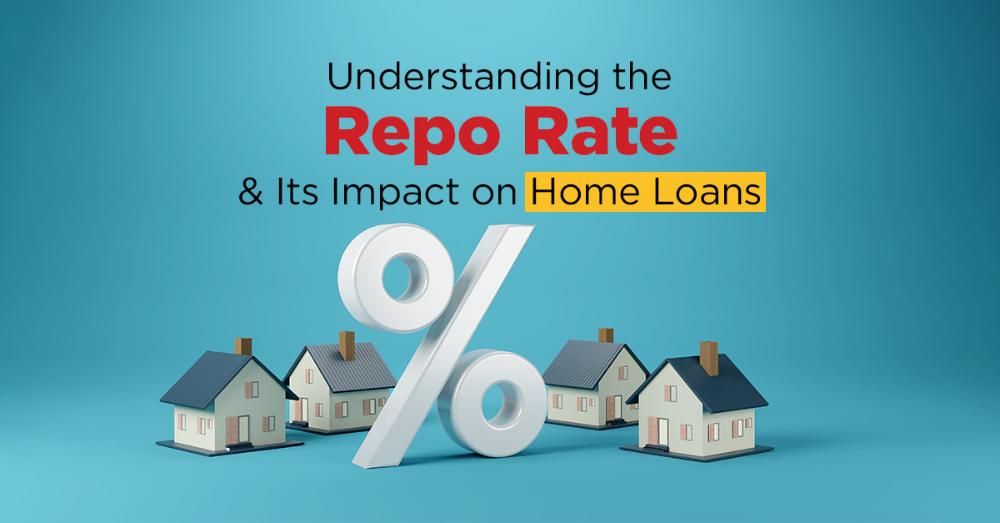How Does the Repo Rate Affect Home Loans?

How Does the Repo Rate Affect Home Loans?
RBI Hikes Repo Rate
The legislative leader of the Reserve Bank of India (RBI) as of late declared an ascent in key strategy rates. As per the declaration, the RBI expanded the repo rate by 50 premise focuses to 4.90 percent from 4.4 percent beforehand. This is the second climb this year, the past one was by 40 premise focuses. How about we figure out what it is meaning for the home advances and venture arranging of home purchasers. The Current RBI Repo Rate: 4.9%.
What is the Repo Rate?
Repo rate is the rate at which the national bank of a nation (Reserve Bank of India for India) provides loan to business banks in case of any setback of assets. Repo rate is utilized by financial specialists to control expansion.
In case of expansion, national banks increment repo rate as this goes about as a disincentive for banks to get from the national bank. This at last diminishes the cash supply in the economy and subsequently helps in capturing expansion.
The national bank takes the opposite position in case of a fall in inflationary tensions. Repo and invert repo rates structure a piece of the liquidity change office.
Home loan repo rate
In April 2019, the Monetary Policy Committee of the RBI declared that the repo rate would be diminished by 25 premise focuses (bps). The RBI has brought down the repo rate from 6.25% to 6%. This is credited to the way that the Indian economy is as of now steady. As a matter of fact, this is the second time in a solitary year that the repo rate has been decreased. To comprehend the impact of repo rate cut on home credit we really want to know how repo rate influences your home advance EMI. This is the way it works out: A low repo rate normally converts into a minimal expense credit for the overall population. Presently, in the event that business banks get cash from the RBI to subsidize credits; when the repo rate is decreased by the RBI, borrowers expect their loaning bank to expand or pass on this advantage of diminished financing costs to them also. At the point when the financing cost on a home credit is diminished, it likewise diminishes the advance EMI.
Moreover, when the repo rate increments, banks increase the financing cost on home credits and clients find home advances costly. Loan specialists charge higher financing costs on the grounds that the RBI and business banks gain the fundamental supports by paying a higher financing cost themselves. This thusly compels them to expand their loaning rates. All things considered, it ought to be noticed that banks ordinarily require some investment to diminish their loaning rates in any event, when the RBI has sliced its rates. In any case, when the repo rate increments, banks quickly increment the financing cost. Thus, notwithstanding the way that the RBI has proactively diminished the repo rate in April, new borrowers need to stand by some time until they can profit this advantage of decreased loan fees.
How Does the Repo Rate Affect Home Loans?(With an example)
Let’s say you have taken out a home loan of ?3,000,000 for tenure of 15 years. If your bank is offering an interest rate of 8.75%, you would be paying a monthly EMI of approximately ?29,983. Now, if the interest rate is reduced by 25bps, and if the bank passes on this benefit (in entirety) to you, the borrower, your monthly EMI amount comes down to ?29,542. While this may not seem like a huge reduction at face value, you could end up saving approximately ?80,000 throughout the tenure of the loan, making it a huge saving in the long term.
Role of the RBI
To guarantee that borrowers can profit from home credit repo rate decreases, the RBI has presented the MCLR or Marginal Cost of Fund Based Lending rates system, under which banks need to charge loan fees in light of RBI rules and the financing cost charges can't be not exactly the breaking point endorsed by RBI to impact the manner in which business moneylenders work. Banks are expected to illuminate their clients regarding the new loan fees every month, for a base residency of 5 years. Under this new MCLR framework, the repo rate and EMI are supposed to have a more grounded relationship as banks can't have an edge higher than 25bps while loaning reserves.
You Can Also read more about Investment here.